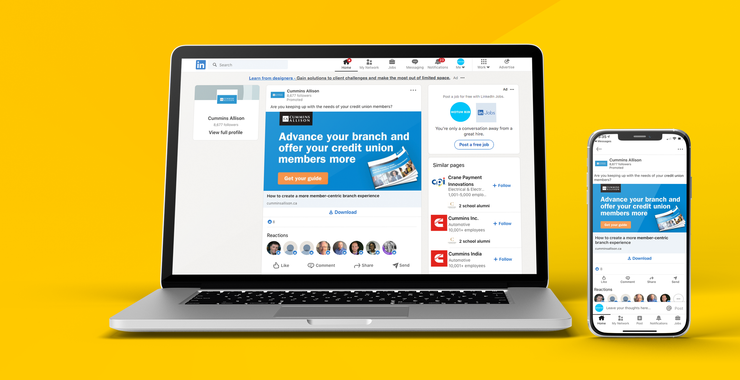The gift of zero-click posts on social media
Our social media specialist says zero-click content is like a present for your social media audience. Find out how it can help B2B marketers educate and build trust.

 Zero-click content is easy to schedule into your existing content rotation.
Zero-click content is easy to schedule into your existing content rotation.
In a digital world where users are constantly being advertised to, even social media posts can be a source of friction. Users scroll in hopes of seeing valuable, informative, or entertaining content but are often prompted to click to another page.
Wamfa Kumdoung, Social Media Specialist at Motum B2B, says zero-click posts are designed to remove that friction.
“The value of zero-click is less transactional and more like a gift,” she says. “It’s showing the user something useful, and if they’re interested, they can engage.”
In B2B, zero-click posts share information about a topic in your wheelhouse, which passively shows off your expertise while teaching users about a concept, idea, or story they find valuable. No strings (or clicks) attached.
What is zero-click?
We recently discussed the impact of zero-click search on B2B marketing. Users increasingly rely on AI summaries in search engines, because it shows the information they need up-front without requiring them to click through to a website.
In social media, zero-click works in a similar way. It provides high-level information to the viewer without the added steps of a call-to-action or link.
Kumdoung says regular social media posts don’t cater much to bottom-of-the-funnel buyers, because detailed and context-heavy posts are generally better suited to a brand's website. On social media, where attention spans are shorter, the focus is more on brand awareness and community building.
Zero-click is about thinking through the funnel from a top-to-bottom perspective. Wamfa Kumdoung, Social Media Specialist
“Zero-click is about thinking through the funnel from a top-to-bottom perspective. At the bottom, you have all the information you want to provide in one post, and at the top you’re thinking about how to make it concise.”
While zero-click shines in its simplicity, there’s an art to making it succinct.
Examples of zero-click posts
Providing all the information in a clear, digestible way is the main challenge in zero-click, because you won’t have that clickthrough to provide more context. Creative formatting makes it easier to share bite-sized info while helping the content stand out.
According to Kumdoung, carousel posts — a series of slides or images — and text-only posts with bullet points are the most common formats. You can also repurpose video, whether it’s short or long-form, and make it zero-click by omitting a link.
Single-image posts like mini-infographics, charts, and statistics are also helpful for sharing bites of information in a visual way.
One of the best ways to create a zero-click post is to repurpose content. You can snip longer videos into short segments, summarize the core points of a blog post, or grab a statistic or chart from a piece of marketing collateral (think reports and whitepapers) to make something that sparks interest.
Educate, don’t preach
How do you know what to summarize or where to snip? Use your knowledge of the audience to choose content that users will find valuable or educational, but not overly complicated. If you’re clipping from a longer-form piece, the zero-click version should also be able to stand on its own and make sense without the added context.
Last but not least, zero-click content should ideally aim to be non-promotional.
“I start by thinking of myself as an educator rather than a promoter,” Kumdoung says. “I ask myself two questions: how can I make this concise, and would someone who is new to the industry be able to engage with this post?”
That’s not to say your audience is made up of newbies, but the content should be accessible to all levels of knowledge. B2B can get very technical, so jargon or complex concepts need to be distilled into simple ideas.
When creating zero-click posts, Kumdoung often asks, “Is this something they would care about and understand?” Then it’s about using the right structure to capture their attention and help them follow along.
Talk to humans
Seeing as zero-click isn’t about getting instant hits or conversions, it’s important to think of it as a long-term strategy aimed at people, not buyers.
Social media algorithms prioritize zero-click content because it keeps people on their platforms, so they’ll reward it by boosting your reach.
“As users see more of your content, they’ll become more aligned and engaged with it, and the algorithm will show them more of it,” Kumdoung explains. “It puts your brand or product on the map and in their brain.”
As users progress through the long sales cycle and decision-making time approaches, a brand that has built up trust and recognition is more likely to come up in discussions.
That means taking the focus away from your product or business to serve up content these decision-makers will understand and find valuable. It means choosing an eye-catching format. And it means using less technical, more human language to help viewers understand everything at a glance.
“At the end of the day, for those sales cycles to complete, you need decision makers. You need stakeholders. You need employees. So, you need to talk to people first.”
Is social media not your thing?
Good news — it’s our thing. Talk to one of our social specialists for strategic guidance.
